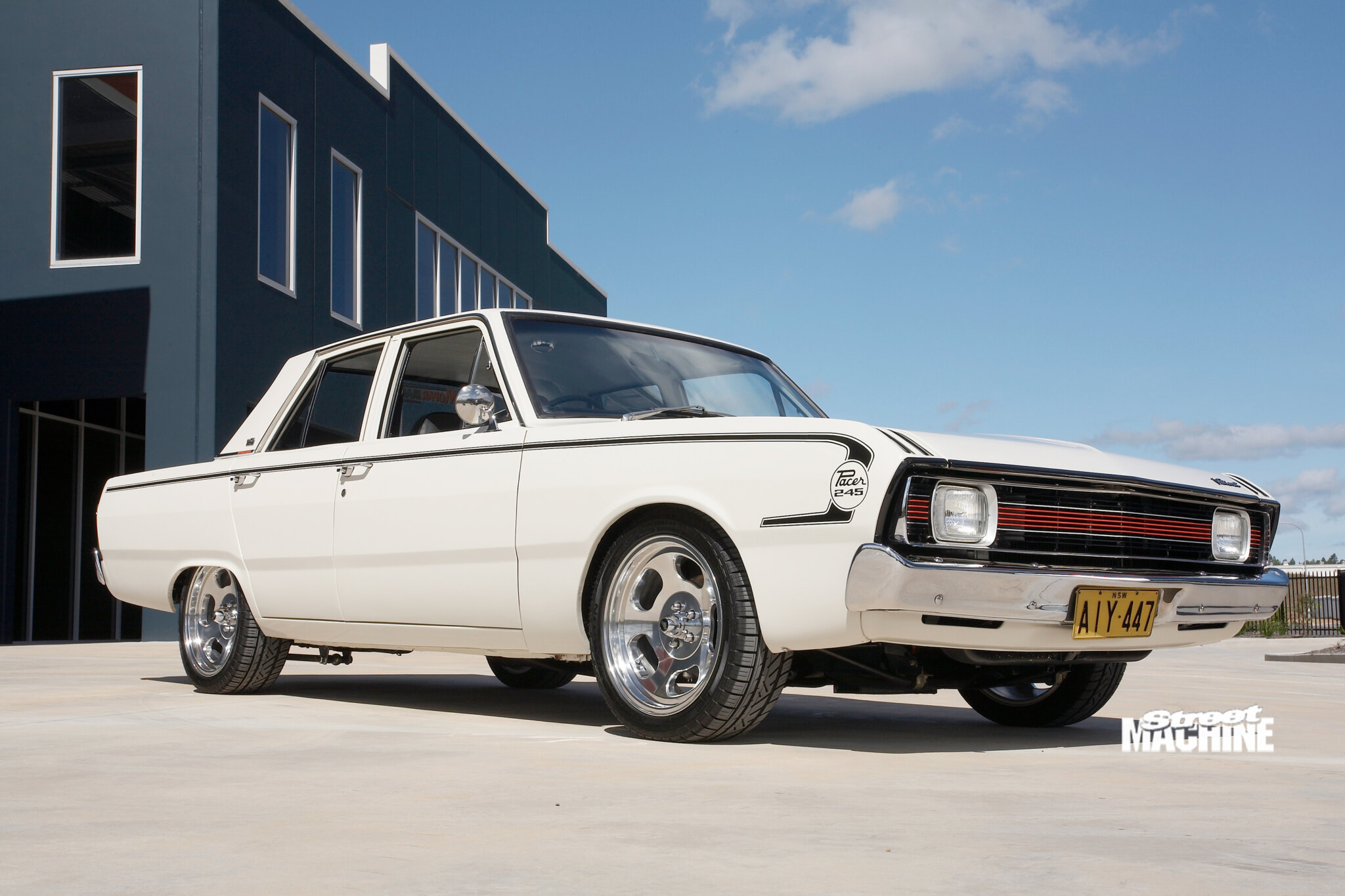
Australia’s performance car scene tends to be split into Holden or Ford camps. But even though Chrysler disappeared from view here for nigh on three decades, there are still plenty of Mopar loyalists fighting the good fight against the Lion and Blue Oval hordes. Nik Ilijic is one of them, which isn’t so surprising considering his VG Pacer is the very same one that brought him home from hospital a day or so after he was born!
First published in the June 2006 issue of Street Machine

Nik’s dad had bought the Pacer brand new back in March ’71, and it served the Ilijic family faithfully until 1996. Its moment of fame was when it was stolen and used as a getaway car after a robbery in ’77. The car became Nik’s daily driver for short time before he handed it over to his brother, who drove it until early 2000.
Now there’s nothing sadder than an abandoned classic car, so Nik started getting some ideas together about reviving the VG and improving a few things along the way.



“A neighbour had a nice AP5 and we used to talk about fuel injection and its advantages,” he said. “When I mentioned it to the mechanic who serviced the car he said: ‘You’ll never do it’, which was all the motivation I needed.”
So fuel injection was at the top of Nik’s to-do list. First he put an XF Falcon throttlebody on a four-barrel manifold, which worked well enough. Then he decided to strip the car down and send the shell away for a freshen-up.

Some freshen-up! The Pacer was away for 14 months while the sills, lower front guards and one rear quarter were all replaced. Thirty years on the road had taken their toll on the slab-sided Pacer, but it’s a bona fide trophy winner now. Covered in DuPont Bondi Bleach, about as white as you can get, with Pacer ‘hockey stick’ stripes that highlight the distinctive shape.
While the body was away, Nik had a change of heart regarding the fuel injection. R/T Chargers had optional triple Webers, so why not adapt triple Weber-style throttlebodies to the Hemi six?


They go together like ham and cheese. Using three throttlebodies from DC&O (02 4647 2778), Nik added a Redline manifold. That was the easy bit. Getting a Haltech E6K ECU to run the set-up was a little trickier.
“Adam from Just Engine Management spent a lot of time getting it right,” Nik said. “He tried things like fitting an equalisation line across the runners to tune it with a MAP sensor, but eventually we went back to TPS load mapping. It runs quite happily in traffic.”

When the shell was returned, rust and bog-free, Nik reassembled it in just six weeks to make it to the 2003 Chryslers On The Murray, Australia’s biggest Chrysler show. He won Best Pacer that year, and has scored a place in the Top 10 at the next three COTMs.
He hasn’t been idle, however, continually tweaking and fiddling to make it as close to perfect as can be. A stock 265 Hemi replaced the original 245 (which is stored away now) but it just couldn’t hack the pace. So Paul Knott built up a tough 265 Hemi pumping out 253hp (189kW). With fuel injection it starts and runs better than a temperamental triple-Weber 265 Hemi ever did. It even embarrassed some late-models at the 2005 Australian Factory Performance Car Nationals at Bathurst. Nik won the 3.0–4.5-litre class in the Conrod Sprint, proving that Valiants can handle as well as go.

At the time of writing, the Pacer’s best ET was 13.4@104mph but the set-up has been improved since then. Nik’s sure there’s more in it now, even though last time on the track he forgot to plug the water temp sensor back in after replacing the fan belt. That sent the ECU haywire, retarding the timing and stuffing up the fuel mixture, but Nik still managed a 13.6 with a much lower mph.
The trusty old three-speed cog-swapper has been put aside, replaced by a BorgWarner four-speed with a custom 10in clutch from Pentastar Parts and Restorations.

“I had a brass-button clutch for about six months,” Nik said. “The current clutch has done more than 60 runs without a problem.”
There’s nothing too fancy in the suspension, and just the trusty old diff that the Pacer has worn since it left Tonsley Park. It now has 3.23:1 gears and an LSD centre, but it’s handled the power okay so far. Nik also has a 3.89 ratio, but it hasn’t spent much time in the car because “it causes traction problems”.

Plans for the future include a Supra five-speed that’s been sitting in Nik’s shed. He’s also thinking about building another car — a Chrysler, naturally. “I love the shape of those fastback Barracudas,” he said.
The Pacer won’t be put up for sale, though. Not when its history goes back to the day it carried its owner home in a bassinet.
BARGAIN BASEMENT PERFORMANCE
The Valiant Pacer doesn’t get the respect it deserves among Australian muscle cars. Based on the 1969 VF sedan, Chrysler Australia’s first performance car had a high-compression version of the venerable 225ci slant-six that put out 175hp — 30hp more than the base version. There was a three-speed floor shift (with no reverse lockout), optional LSD and a selection of bright colours. Inside were high-back front buckets and white-faced gauges.

The VF Pacer wasn’t super quick but being capable of 17.5sec quarter-miles, it wasn’t slow by late-60s standards. Its standout feature was the $2798 price tag — a good $400 under a base Monaro — so Chrysler sold quite a few.
It was only when the next model, based on the VG sedan, arrived that the Pacer really took off. With the new locally built 245ci Hemi under the bonnet, it put out 185hp — 20hp above the base version. Driving through the same three-speed, it was good for more respectable mid-16 ETs. Funky new colours like Bondi Bleach, Kanga Blue, Thar She Blue, and Little Hood Riding Red tied in with a psychedelic ad campaign. The high-backed buckets remained and the dash got a tacho.
A two-door Pacer was spun off the VG hardtop with an auto trans option, but of more interest were the 185hp E31 and 195hp E34. The E31 had a two-barrel carb, the E34 a four-barrel. Each had 40-thou oversize bores, a hotter cam, close-ratio ’box and 35-gallon fuel tank. They were tailored for Series Production racing and the Bathurst 500 (mile) classic. There was also a rare E35 version with the E34 gear except the cam, for better street manners.

The four-barrel cars were quicker than the two-barrels in a straight line but suffered badly from carby orientation and surge in corners, so the two-barrel cars were favoured for circuit racing. They did well against more powerful V8 Falcon GTs and Monaros, placing fourth and fifth outright at Bathurst in 1970.
The final Pacer was the VH. Fitted with the more powerful 265 Hemi it was capable of high-15s quarters but Chrysler focused on the Charger and the VH Pacer faded into obscurity.
NIK ILIJIC
1970 VG VALIANT PACER
| Colour: | DuPont Bondi Bleach |
| GRUNT | |
| Engine: | 277ci Hemi six (265ci + 90-thou overbore) |
| Throttlebodies: | DC&O 45mm Weber-style |
| Manifold: | Redline triple-Weber |
| Injectors: | Bosch 431 |
| Head: | Ported 265, 2.02in inlet, 1.6in exhaust |
| Pistons: | ACL 5.7-litre Race Series |
| Rods: | Six-Pack |
| Crank: | Knife-edged |
| Cam: | Solid 256deg@50-thou, 0.578in lift |
| Ignition: | DFI waste spark, triple dual-output coils, M&W three-channel igniter |
| Fuel system: | Carter Black, surge pot, Bosch 910 EFI |
| ECU: | Haltech E6K |
| Exhaust: | Ceramic-coated custom headers |
| SHIFT | |
| Gearbox: | BorgWarner four-speed |
| Clutch: | Custom 10-inch six-bolt clutch |
| Diff: | Borg-Warner 78-series, 3.23:1, two-pinion LSD |
| BENEATH | |
| Springs: | 1.5in reset leaves, home-made Caltrac bars (r) |
| Shocks: | Monroe GT gas (f&r) |
| Bushes: | Rubber/Nolathane |
| ROLLING | |
| Rims: | 17×7 American Racing Ansen Sprint |
| Rubber: | 225/45R17 Pirelli Dragon |
THANKS
Dad Steve, Robert & George from Georob Smash Repairs, Paul & Graham from Paul Knott Automotive, Paul Dunk from Blue Star Spares, Adam from Just Engine Management, Ray Webb from Pentastar Parts and Restorations, and the Chrysler and Valiant Owners Association Ltd.





